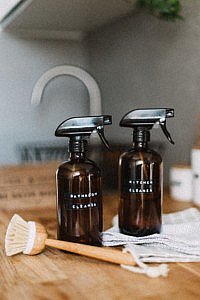The Zero Waste Kitchen
Zero waste is not a new concept; not that long ago, not wasting anything was vital to survival. Now with the amount of waste that we're dumping into our environment, we are starting to move back towards zero-waste living. Completely changing the way we shop and cook sounds a bit daunting, but Kate Charles (dclutterd) is here to help us with tips on building up a zero-waste kitchen.1. Shopping and storage
The first idea in understanding zero waste is refusing to accept waste in the first place. That might mean choosing items that have no packaging over those that do and politely declining leaflets, freebies, and samples. Another way to avoid packaging is to bring your own containers to zero-waste shops, and fill them from bulk dispensers. Most of these shops charge by weight, so you can bring any empty container to the shop - fill it to your hearts content - and pop it back in the cupboard when you get home. More and more shops are waking up to the shift in attitude against packaging waste, making this a much easier venture than it used to be. The following list is a great guideline for reusable storage options that you can take shopping and store your food in: Bread and bakery goods - cloth bags, or re-used plastic bread bags, sturdy paper bags can be used several times Dry goods - Cloth or mesh bags, plastic or glass tubs with sealed lids, or sturdy paper bags Vegetables - Washable mesh bags, re-used plastic bags, re-used mushroom cartons Oils/vinegars and other liquids - two designated containers that can have the same liquid put into it every time - when one runs out, start on the second and put the first into the 'for refilling' bag Meat and fish - Glass or reusable plastic containers with sealed lids are best, compost-able paper2. Food waste - tops, tails and leftovers
Chopping fresh veg is a particular pleasure of mine - the aroma of a freshly-cut leek, or minced garlic starts my mouth watering before I've cooked a single thing! Once it's in the pan, you are generally left with some peel, skins, roots and leaves. But before throwing your undesirables in the bin, consider these eco-friendly options. Depending on what you have at your disposal, you may be able to plant seeds, pits or parts of root vegetables to grow your own produce at home. If that's not an option, chuck all of your food waste into a container in the freezer and when it's full boil it down and strain it for your own broth. For more ideas on how to reuse your food waste, visit our recent blog post about how to reuse your leftovers. If these options are not right for you, check out some other things you can do with leftover food: Use a compost or wormery - if you have a garden, you can start a compost or womery where you can cultivate your own fertiliser Bokashi bins - odour-free composting systems in a sealed container are a better option for flats and apartments with no outdoor space Food waste bin - if your council collects food waste, this is a great option, especially for those with no garden or compost bin Storing leftover food can be given a zero-waste makeover too: Swap out your single-use clingfilm for beeswax or soy fabric wraps, or invest in some silicone dish covers that can be washed and reused many times.3. Cleaning and hygiene
Most of what people use in the kitchen is terrible of the environment. Sponges take longer than a human lifetime to decompose, and even "gentle" cleaners contaminate ground water supplies. If you're serious about having a zero-waste kitchen, here are some easy swaps: Plastic scrubbers and sponges - swap for coconut-fibre or loofah scrubbers which last as long as their plastic counterpart, are washable during use and compost-able once finished Paper towels and wipes - cotton cleaning cloths, perhaps cut-up squares of old clothes or bath towels that can be washed and re-used Single-use cleaners - swap for a glass spray bottle with bicarbonate of soda and white vinegar, or your favourite natural cleaning recipe
4. When food goes bad
You can avoid food waste by putting older food at the front of your fridge, planning meals that use up everything you've bought, and cleaning out your fridge on a regular basis. When it happens though, food that has gone bad can still be put into the compost - it's just started composting a little early! Food that you would usually eat raw that hasn't gone off but is a bit squishy can make the best baked goods. For example, bananas that no-one would eat make great banana bread, wrinkly apples make amazing apple sauce and hard bread whizzed in the food processor makes brilliant breadcrumbs.5. Planning and organising
Watch out for some other articles in this series that deal with meal-planning and making grocery lists. Planning is a necessary part of creating a zero-waste kitchen, for example, if you've ditched canned beans for dried (cheaper!) beans, you'll have to soak them overnight before cooking. Making a meal plan is great for this, as you can note 'soak beans!' the day before. Making a grocery list is the best way to avoid impulse purchases, or accidentally buying duplicates - minimising waste, and saving you money! I hope that this article has inspired you to make some changes - if it has, let us know in the comments!It's National Organising Week 2019 and APDO's 15th birthday celebration! We would love for you to join in the fun by following us on our social media channels. If we've inspired you to #NOWorganise please tag us with our hashtags so we can see what you've been up to!
